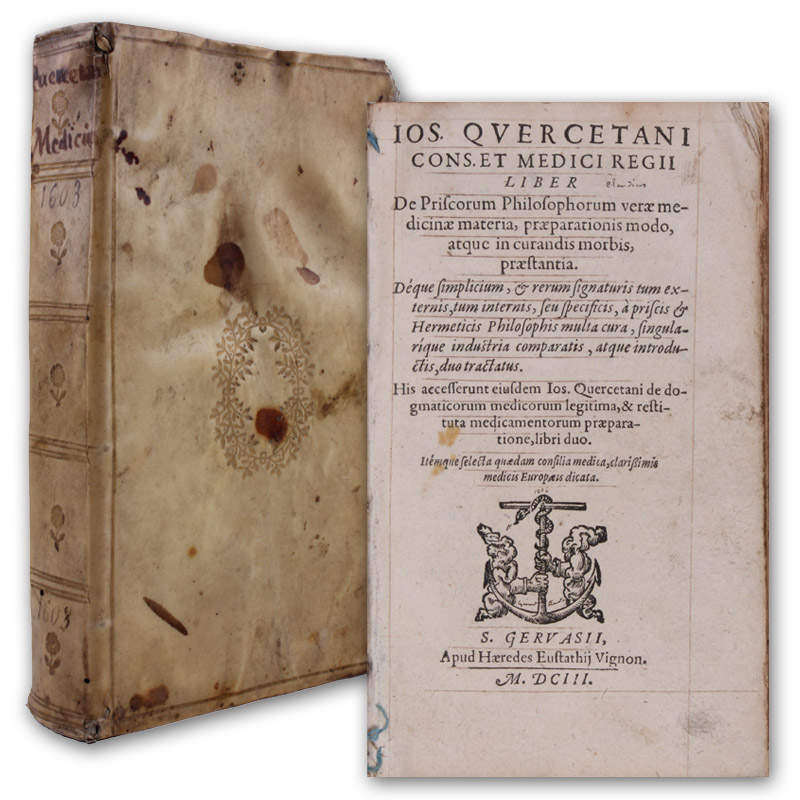116497-01
Liber de priscorum philosophorum verae medicinae materia praeparationis modo.
Saint-Gervais-les-Bains, Vignon, 1603. - (17 x 9,5 cm). (24) 432 (3) S., durchgehend regliert. Flexibler Pergamentband der Zeit mit goldgeprägten Fileten und goldgeprägtem Lorbeerkranz auf den Deckeln.
Der Genfer Arzt Du Chesne (1546-1609) war besonders unter seinem latinisierten Namen Quercetanus bekannt. Er glaubt an die Signaturenlehre, glaubt an die Möglichkeit der Transmutation und preist spagyrische Mittel, besonders das Antimon, überschwenglich an. "Duchesne's medicoscientific works are best seen as part of the late sixteenth-and early seventeenth-century debate on the place of chemistry in medicine and natural philosophy. The flood of Paracelsian texts published in the third quarter of the sixteenth century had gained many adherents to the new medicine, but at the same time it had brought forth strong opposition from the medical establishment... A series of polemical works debating the value of the new medicine and the extent to which chemistry might be employed by physicians were printed in the last quarter of the century. In France the matter reached a climax when Duchesne published his 'De priscorum philosophorum verae medicinae materia...' (1603). This work was immediately answered by the elder Jean Riolan who accused him of wishing to sweep away the venerable medicine of the ancients in his 'Apologia pro Hippocratis Galeni medicina' (1603)" (DSB). - Vorsätze etwas fleckig, mit Beschädigung und Namenszug von alter Hand. Einband etwas fleckig und rechte obere Ecke etwas lädiert. Innen gut erhalten. - DSB 4, 208; Hirsch/H. II, 7; Duveen 492; Ferguson I, 237 (Anm.); Wellcome I, 1882; Krivatsy 3439; Brüning 812
Liber de priscorum philosophorum verae medicinae materia praeparationis modo.
Saint-Gervais-les-Bains, Vignon, 1603. - (17 x 9,5 cm). (24) 432 (3) S., durchgehend regliert. Flexibler Pergamentband der Zeit mit goldgeprägten Fileten und goldgeprägtem Lorbeerkranz auf den Deckeln.
Der Genfer Arzt Du Chesne (1546-1609) war besonders unter seinem latinisierten Namen Quercetanus bekannt. Er glaubt an die Signaturenlehre, glaubt an die Möglichkeit der Transmutation und preist spagyrische Mittel, besonders das Antimon, überschwenglich an. "Duchesne's medicoscientific works are best seen as part of the late sixteenth-and early seventeenth-century debate on the place of chemistry in medicine and natural philosophy. The flood of Paracelsian texts published in the third quarter of the sixteenth century had gained many adherents to the new medicine, but at the same time it had brought forth strong opposition from the medical establishment... A series of polemical works debating the value of the new medicine and the extent to which chemistry might be employed by physicians were printed in the last quarter of the century. In France the matter reached a climax when Duchesne published his 'De priscorum philosophorum verae medicinae materia...' (1603). This work was immediately answered by the elder Jean Riolan who accused him of wishing to sweep away the venerable medicine of the ancients in his 'Apologia pro Hippocratis Galeni medicina' (1603)" (DSB). - Vorsätze etwas fleckig, mit Beschädigung und Namenszug von alter Hand. Einband etwas fleckig und rechte obere Ecke etwas lädiert. Innen gut erhalten. - DSB 4, 208; Hirsch/H. II, 7; Duveen 492; Ferguson I, 237 (Anm.); Wellcome I, 1882; Krivatsy 3439; Brüning 812
1.250 €

